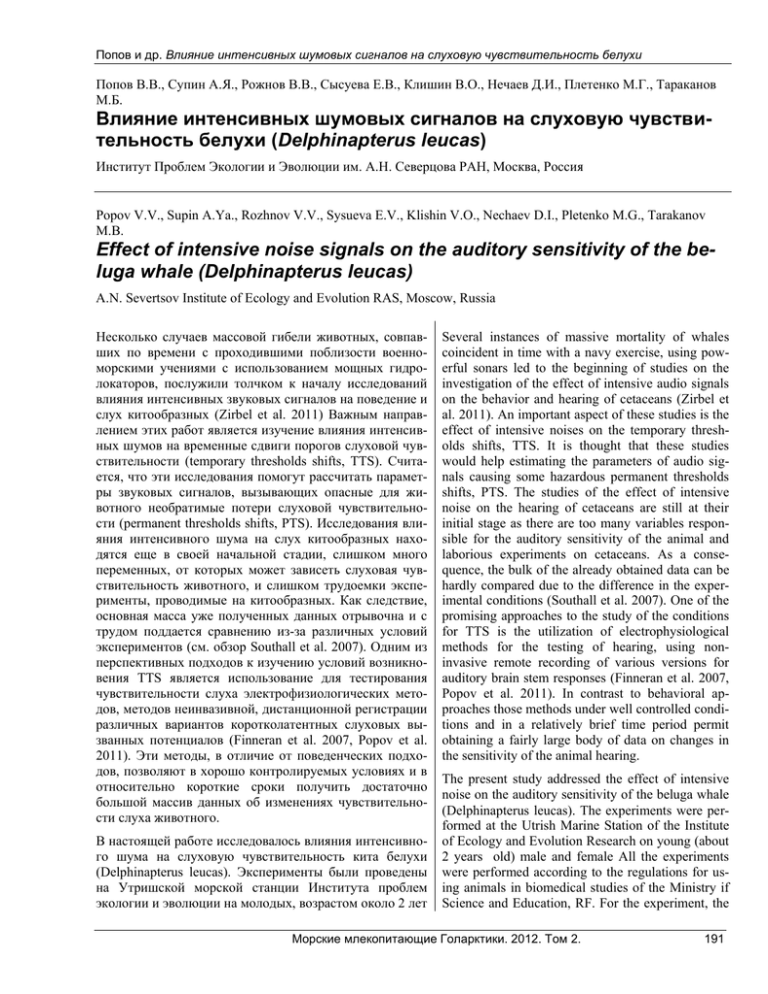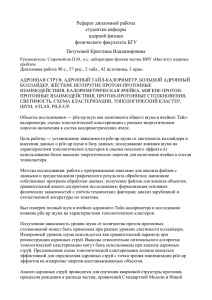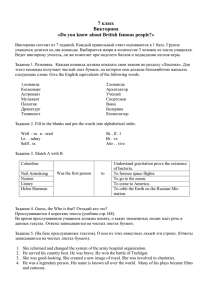"Влияние интенсивных шумовых сигналов на
advertisement

Попов и др. Влияние интенсивных шумовых сигналов на слуховую чувствительность белухи Попов В.В., Супин А.Я., Рожнов В.В., Сысуева Е.В., Клишин В.О., Нечаев Д.И., Плетенко М.Г., Тараканов М.Б. Влияние интенсивных шумовых сигналов на слуховую чувствительность белухи (Delphinapterus leucas) Институт Проблем Экологии и Эволюции им. А.Н. Северцова РАН, Москва, Россия Popov V.V., Supin A.Ya., Rozhnov V.V., Sysueva E.V., Klishin V.O., Nechaev D.I., Pletenko M.G., Tarakanov M.B. Effect of intensive noise signals on the auditory sensitivity of the beluga whale (Delphinapterus leucas) A.N. Severtsov Institute of Ecology and Evolution RAS, Moscow, Russia Несколько случаев массовой гибели животных, совпавших по времени с проходившими поблизости военноморскими учениями с использованием мощных гидролокаторов, послужили толчком к началу исследований влияния интенсивных звуковых сигналов на поведение и слух китообразных (Zirbel et al. 2011) Важным направлением этих работ является изучение влияния интенсивных шумов на временные сдвиги порогов слуховой чувствительности (temporary thresholds shifts, TTS). Считается, что эти исследования помогут рассчитать параметры звуковых сигналов, вызывающих опасные для животного необратимые потери слуховой чувствительности (permanent thresholds shifts, PTS). Исследования влияния интенсивного шума на слух китообразных находятся еще в своей начальной стадии, слишком много переменных, от которых может зависеть слуховая чувствительность животного, и слишком трудоемки эксперименты, проводимые на китообразных. Как следствие, основная масса уже полученных данных отрывочна и с трудом поддается сравнению из-за различных условий экспериментов (см. обзор Southall et al. 2007). Одним из перспективных подходов к изучению условий возникновения TTS является использование для тестирования чувствительности слуха электрофизиологических методов, методов неинвазивной, дистанционной регистрации различных вариантов коротколатентных слуховых вызванных потенциалов (Finneran et al. 2007, Popov et al. 2011). Эти методы, в отличие от поведенческих подходов, позволяют в хорошо контролируемых условиях и в относительно короткие сроки получить достаточно большой массив данных об изменениях чувствительности слуха животного. В настоящей работе исследовалось влияния интенсивного шума на слуховую чувствительность кита белухи (Delphinapterus leucas). Эксперименты были проведены на Утришской морской станции Института проблем экологии и эволюции на молодых, возрастом около 2 лет Several instances of massive mortality of whales coincident in time with a navy exercise, using powerful sonars led to the beginning of studies on the investigation of the effect of intensive audio signals on the behavior and hearing of cetaceans (Zirbel et al. 2011). An important aspect of these studies is the effect of intensive noises on the temporary thresholds shifts, TTS. It is thought that these studies would help estimating the parameters of audio signals causing some hazardous permanent thresholds shifts, PTS. The studies of the effect of intensive noise on the hearing of cetaceans are still at their initial stage as there are too many variables responsible for the auditory sensitivity of the animal and laborious experiments on cetaceans. As a consequence, the bulk of the already obtained data can be hardly compared due to the difference in the experimental conditions (Southall et al. 2007). One of the promising approaches to the study of the conditions for TTS is the utilization of electrophysiological methods for the testing of hearing, using noninvasive remote recording of various versions for auditory brain stem responses (Finneran et al. 2007, Popov et al. 2011). In contrast to behavioral approaches those methods under well controlled conditions and in a relatively brief time period permit obtaining a fairly large body of data on changes in the sensitivity of the animal hearing. The present study addressed the effect of intensive noise on the auditory sensitivity of the beluga whale (Delphinapterus leucas). The experiments were performed at the Utrish Marine Station of the Institute of Ecology and Evolution Research on young (about 2 years old) male and female All the experiments were performed according to the regulations for using animals in biomedical studies of the Ministry if Science and Education, RF. For the experiment, the Морские млекопитающие Голарктики. 2012. Том 2. 191 Popov et al. Effect of intensive noise signals on the auditory sensitivity of the beluga whale самце и самке. Все эксперименты проводились в соответствии с правилами использования животных в биомедицинских исследованиях Министерства Науки и Образования РФ. На время эксперимента животное в специальных носилках помещалось в ванну с морской водой (4,5х0,85х1,2 м) таким образом, чтобы дорсальная поверхность головы с дыхалом находилась над поверхностью воды. Для неинвазивной регистрации вызванных потенциалов использовались дисковые электроды диаметром 15 мм из нержавеющей стали, вмонтированные в латексные 60 мм присоски. Активный электрод крепился на поверхности головы в 7 см каудальнее дыхала, индифферентный на спине животного. Оба электрода находились над поверхностью головы. Электрическая активность, регистрируемая от поверхности головы, усиливалась в частотной полосе от 200 до 5000 Гц, оцифровывалась и запоминалась в памяти компьютера. Для выделения ответа из шума использовался метод когерентного усреднения, относительно начала стимула. В качестве тестового стимула использовалась серия тональных посылок, длительностью 16 мс, содержащая 16 тональных посылок, следующих с частотой 1000/сек. Несущая частота тональных посылок менялась от 8 до 128 кГц. Такой тип стимула очень эффективен в вызове ритмического слухового вызванного потенциала, по своей природе аналогичному потенциалу следования огибающей, ПСО (Supin and Popov 2007). В качестве подавляющего звукового сигнала использовался полуоктавный полосовой шум с центральными частотами от 11,2 до 90 кГц. Тестовый и подавляющий звуковые сигналы предъявлялись животному с помощью пьезокерамических излучателей: ITC-1032 (International Transducer Corporation, USA) для частот 8-45 кГц или B&K 8104 (Bruel & Kjaer, Denmark) для частот сигнала 64-128 кГц. Эксперименты проводились по следующей схеме: перед каждой серией с предъявлением подавляющего шума у животного определялся порог на частоте теста (фоновый порог). Затем включался подавляющий шум с центральной частотой в разных сериях 11,2, 22,5, 45 или 90 кГц, длительностью 1, 3, 10 или 30 мин. После выключения шума определялись пороги на тестовый стимул. Частота тестового стимула могла совпадать с центральной частотой шума, быть на 0,5 октавы ниже или на 0,5, 1, 1,5 октавы выше. Определение порогов на тестовый стимул начиналось сразу после окончания подавляющего шума и продолжалось до полного восстановления порога, но не превышало по длительности 1 часа, даже в том случае, когда порог не достигал фоновых значений. Предъявление интенсивного шумового сигнала вызывало резкий подъем слуховых порогов (TTS). На рис. 1 представлены графики восстановления порога (зависимость TTS от времени после окончания подавляющего шума с центральной частотой 45 кГц, интенсивностью 192 animal in a special stretcher was placed in a bathtub with sea water (4.5х0.85х1.2 m) so that the dorsal surface of the head with the blowhole was over the water surface. For non-invasive recording of evoked potentials disk electrodes of stainless steel were used, 15 mm, installed into 60 mm sucker cups. The active electrode was fixed on the head 7 cm caudal of the blowhole; and the indifferent electrode on the back of the animal. Both electrodes were over the head surface. The electrical activity recorded from the head surface amplified in the frequency range from 200 to 5000 Hz, was digitized and recorded in the computer memory. In order to distinguish response from the noise, the method of coherent averaging in relation to the beginning of the stimulus. Used as a test stimulus was a series of 16 ms in duration, containing 16 tone bursts at a frequency of 1000/sec. The tone burst carrier frequency ranged from 8 to 128 kHz. That type of stimulus is very effective in evoking a rhythmical potential, which in its nature is similar envelope following response (EFR) (Supin and Popov 2007). Used as the fatiguing signal was the semi-octave bandpass noise with central frequencies from 11.2 to 90 kHz. The animal was exposed to the test and fatiguing audio signals with ceramic transducer: ITC-1032 (International Transducer Corporation, USA) for the frequencies 8-45 kHz or B&K 8104 (Bruel & Kjaer, Denmark) for the frequencies of the signal 64-128 kHz. The experimental pattern was the following: before each series when the animals were exposed to the fatiguing noise, the test frequency threshold was determined (background threshold). Subsequently, the fatiguing noise was turned on with the central frequency in different series of 11.2, 22., 45 or 90 kHz, with a duration of 3, 10 or 30 minutes. When the noise was turned off, the thresholds were determined to the test stimulus. The frequency of the test stimulus could coincide with the central noise frequency, be 0.5 octave lower or by 0.5, 1, 1.5 octave higher. The determination of the threshold to the test stimulus started directly after the threshold was restored completely but it did not exceed one hour even in case when the threshold did not reach the background values. Exposure to an intensive noise signal caused a sharp temporary threshold shift (TTS). Fig. 1 shows diagrams of the restoration of the threshold (the relationship of the TTS and the time after end of the fatiguing noise with a central frequency of 45 kHz, the intensity of 165 dB, the duration of exposure of 10 minutes, for test signals with a frequency of 32, 45 and 64 kHz. The maximal threshold shift (42.5 Marine Mammals of the Holarctic. 2012. Vol. 2. Попов и др. Влияние интенсивных шумовых сигналов на слуховую чувствительность белухи 165 дБ, длительностью экспозиции 10 мин) для тестовых сигналов частотой 32, 45 и 64 кГц. Максимальный сдвиг порога (42,5 дБ) наблюдался при частоте теста 64 кГц (+0.5 октавы относительно частоты шума). При частоте теста 32 кГц (-0,5 окт.) TTS не фиксировался, а при частоте теста совпадающей с частотой шума значения максимального повышения порога были в два раза меньше, чем при тесте 64 кГц. dB) was recorded at a test frequency of 64 kHz (+0.5 octave in relation to the noise frequency). At a frequency test 32 kHz (-0.5 octave) TTS was not recorded, and at a frequency test coinciding with the frequency of the noise, the values of the maximal increase of the threshold were twice as low compared with the test of 64 kHz. На рис. 2 суммированы данные по сравнению слуховой чувствительности у белухи в покое и после предъявления подавляющего шума (165 дБ) с центральными частотами 11,2, 22,5, 45 и 90 кГц. Максимальное падение чувствительности наблюдалось в частотных областях на 0,5-1 октаву выше центральной частоты подавляющего шума, что совпадает с данными других работ (Schlund et al. 2000, Nachtigall et al. 2004). Шум, воздействующий на низкочастотные области слуха белухи, более эффективно подавляет слуховую чувствительность. Fig. 2 provides a summary data on comparison of auditory sensitivity in a resting beluga whale and upon exposure to the rejection noise (165 dB) with central frequencies of 11.2, 22.5, 45 and 90 kHz. The maximal decrease in sensitivity was recorded in the frequency areas of 0.5-1 higher than the central frequency of the rejection noise, which coincides with data of other operations (Schlund et al. 2000, Nachtigall et al. 2004).The noise affecting the lowfrequency areas of the beluga whale hearing more effectively suppresses the auditory sensitivity. Исследование выполнено при поддержке Русского географического общества и РФФИ (грант 12-04-00654-а). The study was supported by the Russian Geographical Society and RFFI (Grant т 12-04-00654-а). Рис. 1. Пример восстановления порогов после предъявления шума с центральной частотой 45 кГц, длительностью экспозиции 10 мин и интенсивностью 165 дБ для трех тестовых частот: 32, 45 и 64 кГц Fig. 1. An example of restoration of the threshold with a central frequency of 45 kHz, the duration of exposure of 10 minutes and intensity of 165 dB for three test frequencies: 32, 45 and 64 kHz Морские млекопитающие Голарктики. 2012. Том 2. 193 Popov et al. Effect of intensive noise signals on the auditory sensitivity of the beluga whale Рис. 2. Фоновая аудиограмма и изменение порогов после воздействия полуоктавного шума интенсивностью 165 дБ отн. 1 мкПа, длительностью экспозиции 10 мин. Заштрихованные колонки обозначают спектральную ширину шума (с центральными частотами 11,2, 22,5, 45 и 90 кГц, указаны около графиков). Изменение порогов измерялось от 1.5 до 60 мин после окончания действия шума, как указано в легенде Fig. 2. The background audiogram and changes in the thresholds upon the effect of the semi-octave noise at an intensity of 165 dB in relation to 1µPa, duration of exposure 10 minutes. The hatched columns designate the spectral width of the noise (with central frequencies of 11.2, 22.5, 45 and 90 kHz stated near the graphs). Changes in the thresholds ranged from 1.5 to 60 minutes after the termination of the noise as stated in the legend. Список использованных источников / References Finneran J.J., Schlundt C.E., Branstetter B., Dear R. 2007. Assessing temporary threshold shift in a bottlenose dolphin (Tursiops truncatus) using multiple simultaneous auditory evoked potentials. J. Acoust. Soc. Am., 122: 12491264. Nachtigall P.E., Supin A.Ya., Pawloski J., Au W.W.L. 2004. Temporary threshold shift after noise exposure in the bottlenose dolphin (Tursiops truncatus) measured using evoked auditory potentials. Marine Mammal Science, 20: 673-687. Popov V.V., Supin A.Ya., Wang D., Wang K., Dong L., Wang S. 2011. Noise-induced temporary threshold shift and recovery in Yangtze finless porpoises Neophocaena phocaenoides asiaeorientalis. J. Acoust. Soc. Am., 130: 574-584. Southall B.L., Bowles A.E., Ellison W.T., Finneran J.J., Gentry R.L., Greene C.R. Jr., Kastak D., Ketten D.R., Miller J.H., Nachtigall P.E., Richardson W.J., Thomas J.A., Tyack P.L. 2007. Marine mammal noise exposure crite194 Marine Mammals of the Holarctic. 2012. Vol. 2. Попов и др. Влияние интенсивных шумовых сигналов на слуховую чувствительность белухи ria: Initial scientific recommendations. Aquat. Mamm., 33: 411-414. Schlundt C.E., Finneran J.J., Carder D.A., Ridgway S.H. 2000. Temporary shift of masked hearing thresholds of bottlenose dolphins, Tursiops truncatus, and white whales, Delphinapterus leucas, after exposure to intense tones. J. Acoust. Soc. Am., 107: 3496-3508. Supin A.Ya., Popov V.V. 2007. Improved techniques of evoked-potential audiometry in odontocetes. Aquatic Mammals, 33: 17-26. Русскова О.В. , Шпак О.В. , Краснова В.В.², Кузнецова Д.М. , Тарасян К.К. , Глазов Д.М. , Рожнов В.В. Типы кожных поражений у белух (Delphinapterus leucas) в водах России по фотоидентификационным данным 1. Институт проблем экологии и эволюции им. А.Н. Северцова РАН, Москва, Россия 2. Институт океанологии им. Ширшова РАН, Москва, Россия Russkova O.V.1, Shpak O.V.1, Krasnova V.V.2, Kuznetsova D.M.1, Tarasyan K.K.1, Glazov D.M.1, Rozhnov V.V.1 Type of skin lesions of beluga whales (Delphinapterus leucas) in Russian waters based on photoID data 1. A.N. Severtsov Institute of Ecology and Evolution RAS, Moscow, Russia 2. Shirshov Institute of Oceanology RAS, Moscow, Russia Метод фотоидентификации морских млекопитающих для популяционных исследований впервые был использован ещѐ в 1970-х гг. Белухи лишены контрастного окраса и выступающего спинного плавника, поэтому их индивидуальная идентификация основывается, в основном, на различиях профилей спинного гребня и заметных кожных дефектах на видимых поверхностях обеих сторон корпуса (McGuire et al. 2011). Последние, как правило, имеют различное происхождение. The method of photo identification of marine mammals for population studies was first used back in the 1970s. Beluga whales lack any contrasting coloration or the dorsal fin, hence their identification is largely based on distinguishing of the profiles of the dorsal ridge and the visible skin defects on the visible surfaces of both sides of the body (McGuire et al. 2011). The latter normally differ in origin. Полученный в результате работ по фотоидентификации материал может быть использован для выявления кожных повреждений различного происхождения. Можно оценить относительную нагрузку естественных врагов на популяцию (Higdon et al. 2009), пути миграции (Dwyer et al. 2011), зафиксировать травмы антропогенного происхождения (McGuire et al. 2011), а также отследить распространение различных инфекционных поражений кожи (Van Bressem et al. 2009). Все это в совокупности дополняет информацию о факторах, которые могут оказывать неблагоприятное влияние на состояние популяций белух в различных частях ареала. The material obtained as a result of photo identification can be used to reveal cutaneous lesions of various origins. The pressure of natural enemies on the population can be assessed (Higdon et al. 2009), migration routes can be traced (Dwyer et al. 2011), anthropogenic injuries can be checked (McGuire et al. 2011), and the distribution of various infectious lesions of the skin can be recorded (Van Bressem et al. 2009). Such information helps to assess the factors affecting the beluga whale populations in different parts of the areal. Целью нашей работы является выявление и классификация типов кожных повреждений белух в различных местах обитания, возникших вследствие воздействия разнообразных факторов окружающей среды и могущих оказать негативное воздействие на состояние здоровья жи- The objective of the present study was to use photo identification data to reveal and classify the types of cutaneous lesions of beluga whales in different parts of their habitat caused by various environmental factors and affecting the health of the animals under study Морские млекопитающие Голарктики. 2012. Том 2. 195

